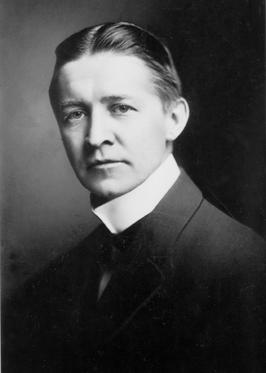
Bertram Grosvenor Goodhue was an American architect celebrated for his work in Gothic Revival and Spanish Colonial Revival design. He also designed notable typefaces, including Cheltenham and Merrymount for the Merrymount Press. Later in life, Goodhue freed his architectural style with works like El Fureidis in Montecito, one of the three estates designed by Goodhue.

St. Mark's Episcopal Church is an historic Episcopal church located at 6-8 Highland Street in Ashland, New Hampshire, in the United States. Organized in 1855, it is part of the Episcopal Diocese of New Hampshire. Its building, completed in 1859, was designed by New York City architect J. Coleman Hart, and is one of the region's most distinctive churches, having a Gothic Revival design built out of half-timbered brick. On December 13, 1984, the church building was added to the National Register of Historic Places. The current pastor is Rev. Tobias Nyatsambo.
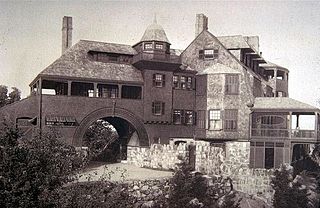
The shingle style is an American architectural style made popular by the rise of the New England school of architecture, which eschewed the highly ornamented patterns of the Eastlake style in Queen Anne architecture. In the shingle style, English influence was combined with the renewed interest in Colonial American architecture which followed the 1876 celebration of the Centennial. The plain, shingled surfaces of colonial buildings were adopted, and their massing emulated.

The Church of the Ascension is a historic Episcopal church building located at 160 Rock Street in Fall River, Massachusetts. It was completed in 1875 and added to the National Register of Historic Places in 1983. It is also located within the Lower Highlands Historic District.

Zion Memorial Chapel, now known as St. Nicholas-on-the-Hudson, is an historic Carpenter Gothic style Episcopal church building located at 37 Point Street in New Hamburg, New York, United States. It was built in 1902 as a chapel of nearby Zion Church in Wappingers Falls and became a separate parish in 1983.

St. Michael's Church, also known as St. Michael's Chapel and Hannah More Chapel, is a historic Episcopal Church located at Academy Lane and Reisterstown Road in Reisterstown, Baltimore County, Maryland. It is a small, Carpenter Gothic-style, board and batten frame structure, featuring a simple bell-gable. It was designed by New York architect John W. Priest (1825-1859), and constructed about 1853. It was named after Hannah More. It was deconsecrated on May 12, 1978.
Charles Emmett Cassell was a Baltimore, Maryland-based architect.
Ernest Albert Coxhead (1863–1933) was an English-born architect, active in the United States. He was trained in the offices of several English architects and attended the Royal Academy and the Architectural Association School of Architecture, both in London. He moved to California where he was the semi-official architect for the Episcopal Church. At the beginning of his career, Ernest Coxhead focused on designing churches, primarily in the Gothic Revival style. After the mid-1890s, Coxhead focused on residential designs. He was involved in the emergence of the Arts and Crafts style in California. He succeeded in designing residences that incorporated the elements and character of the English country house - shingled, Arts and Crafts style English Vernacular Cottages that combined elements from different periods for dramatic effect.

Trinity Chapel, also known as St. John's Church and Beth-El Temple Church of God in Christ, is a historic Episcopal church at 1874 Mott Avenue in Far Rockaway, Queens, New York. It was built in 1858 to the design of architect Richard Upjohn (1802–1878). It is a frame Gothic Revival style chapel on a brick foundation and three bays wide by five bays long. It has a steeply pitched roof and sided in wood shingles. Atop the roof is a wooden belfry with steeply pitched pyramidal roof. It was founded as Trinity Chapel as a mission of Trinity Church in Hewlett, New York. Its name was changed to St. John's of Far Rockaway in 1881 when it became an independent parish. St. John's merged with Trinity Church in 1974 and the building was sold the following year to Beth-El Temple Church of God in Christ.
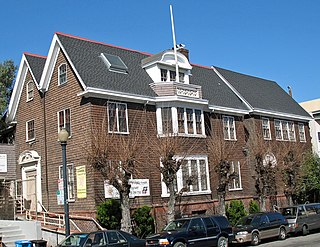
The Girls Club in San Francisco, California, also known as Mission Neighborhood Capp St. Center, was built in 1911 in the Bay Area Tradition version of Shingle Style architecture. It was listed on the National Register of Historic Places in 1979.

The Pacific Improvement Company (PIC) was a large holding company in California and an affiliate of the Southern Pacific Railroad. It was formed in 1878, by the Big Four, who were influential businessmen, philanthropists and railroad tycoons who funded the Central Pacific Railroad, (C.P.R.R.). These men were: Leland Stanford (1824–1893), Collis Potter Huntington (1821–1900), Mark Hopkins (1813–1878), and Charles Crocker (1822–1888). They owned the company, each with 25% interest. Archived records date from 1869 to 1931.

St. Paul's Episcopal Church is a parish church in the Diocese of Iowa. The church is located in Harlan, Iowa, United States. It has been listed on the National Register of Historic Places in 1978.
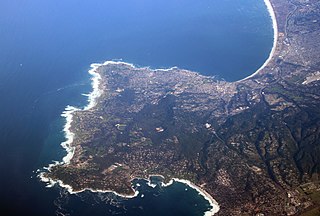
The Monterey Peninsula anchors the northern portion on the Central Coast of California and comprises the cities of Monterey, Carmel, and Pacific Grove, and the resort and community of Pebble Beach.
First Bay Tradition was an architectural style from the period of the 1880s to early 1920s. Sometimes considered as a regional interpretation of the Eastern Shingle Style, it came as a reaction to the classicism of Beaux-Arts architecture. Its characteristics included a link to nature and use of locally sourced materials such as redwood. It also incorporated an emphasis on craftsmanship, volume, form, and asymmetry. The tradition was rooted in San Francisco and the greater Bay Area. The Environmental Design Archives at the University of California, Berkeley house a repository of drawings and specifications associated with this tradition.

St. Augustine of Canterbury Anglican Church is a historic church at 230 Salem Street in the South Campus Neighborhood of Chico, California, United States. It was built in 1905 at the southeast corner of West Fifth and Broadway Streets in Downtown Chico. The building was moved about three blocks, in 1912, to the northwest corner of West Second and Salem Streets.
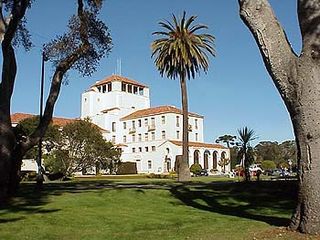
The Hotel Del Monte was a large resort hotel in Monterey, California, from its opening in 1880 until 1942. It was one of the finest luxury hotels in North America. During World War II, it closed and the building was leased to the United States Navy. It first was used by the Navy as a school where enlisted men spent the second, third, and fourth months of an 11-month course being trained as electronic technicians. Later the Hotel Del Monte became the Naval Postgraduate School. Today, the building is named Herrmann Hall. It contains school administrative offices and the Navy Gateway Inns and Suites, a hotel.

The Gov. Frank West Rollins House is a historic house at 135 North State Street in Concord, New Hampshire, United States. The house was built in 1890 for Frank West Rollins, a politician and eventual governor of New Hampshire, by the Boston firm of Andrews, Jaques & Rantoul. It is one of the most elaborate area instances of Shingle style architecture. The house was listed on the National Register of Historic Places in 1984.

St. John's Episcopal Church is a historic church located at 154–158 W. High Street in the borough of Somerville in Somerset County, New Jersey. Built in 1895, it was designed by architect Horace Trumbauer in Early English Gothic style. St. John's Church Complex, which includes the church, rectory, and parish hall, was added to the National Register of Historic Places on May 30, 2003 for its significance in architecture and social history.
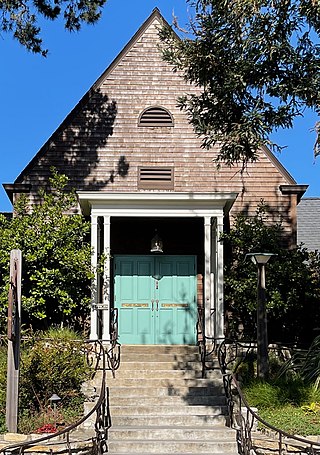
Carmel City Hall, is the seat of the municipal government of Carmel-by-the-Sea, California. It is a historic commercial building in the Carmel downtown district, located on Monte Verde Street and 7th Avenue. It is a good example of Shingle and American Craftsman architectural that was built in the 1910s. The building qualified as an important building in the city's downtown historic district property survey and was recorded with the California Register of Historical Resources on November 22, 2002.

Robert R. Jones was an American architect in Carmel-by-the-Sea, California best known for his Modern architecture. Jones designed numerous residences and commercial buildings in the Monterey Peninsula. In the post-war period, he emerged as a prominent figure among architects and designers who played a pivotal role in shaping Carmel's modernist landscape from the middle 20th century onward. His was known for his design aesthetic that was a Modern architecture-style, combined with elements from the Second Bay Tradition. His creation, the Monterey Airport Administration building, was honored with a design award by the Smithsonian Institution.




















